
Loaded up and ready to ride! Cargo e-bikes make great kiddo haulers. Photo: Matt Medendorp//The Inertia
It’s the e-bike revolution, we’re just living through it. We love e-bikes: they improve physical accessibility to what can be an exclusive sport and get more people on bikes and out of cars. Gaining in popularity and geared for the urban commuter: Cargo e-bikes are the pick-up trucks of the e-bike world. Heavy, durable, a bit more expensive, but capable of hauling loads of gear, from groceries to groms.
In day-to-day life cargo-e bikes aren’t a replacement for good old-fashioned pedal bikes, but for the family car. Our team has tested dozens of e-bikes and focused on cargo haulers for this guide. Check out the best electric cargo bikes of 2025.
Navigate To: Comparison Table | How We Tested | Buyer’s Guide
Related: Best Electric Bikes | Best Fat Tire E-Bikes | Other Electric Bike Reviews
Editor’s Note: We updated this guide in June 2025 with a couple of new picks, improved navigation, and refreshed formatting.
The Best Electric Cargo Bikes of 2025
Best Overall Cargo E-Bike: Specialized Haul LT
Best Value Cargo E-Bike: Lectric XPedition 2.0
Runner-Up Best Cargo E-Bike: Aventon Abound SR
Best Compact Cargo E-Bike: Tern HSD S11
Best for Families: Rad Power Bikes Radwagon 5
Best Front Cargo Bike: Bunch Bike 4+
Best Overall Cargo E-Bike
Specialized Haul LT ($3,500)
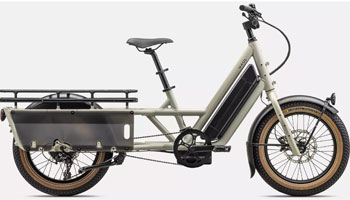
Throttle: Yes
Class: 2, 3
Range: 60 miles
Carrying Capacity: 441 lbs
Power Output: 750 W
Bike Weight: 88 lbs
Pros: Bigger range, handles the best and most like a classic bike, and curious cargo carrying capacity
Cons: Pricier and no front fork suspension
Best For: Cyclists who want a cargo e-bike, performance
When it comes to making a cargo bike, it’s helpful to start with a bike company. Specialized is one of just a couple on this list that also make regular bikes, and it shows in the Haul LT. The geometry, components, and overall feel of the bike consistently outperformed every bike on this list.
With the largest array of customization options, this is really the pickup truck of electric bikes. We consistently chose this bike over the other options on the list. It’s fun and natural to ride. The geometry feels right and once you get used to the fishtail feel of having an extended cargo bed, it can rip.
The battery range is just north of the average (60 miles compared with 58.5), which is excellent considering how large the bike is. With size, range, and handling factored in, no other bike could best the Haul LT.
The throttle is effective to kickstart speed on busy intersections or up hills. And we found this bike could edge a little faster than the 28 mph speed limit imposed on other bikes (if you had the legs to take it there). The display is small and not distracting, leaving your sightlines clear. The customizable cargo panniers are simple and effective – easy to use for more efficient storage in a tight garage and bomber to put back on, especially with the included cargo nets.
As mentioned, the LT takes a bit to get used to handling-wise. But it’s also the easiest to pedal sans battery — something we tested on each one of these bikes.
The Haul’s lack of front fork suspension is its biggest hindrance, but testers found that this didn’t affect day-to-day handling. Because of the size and weight of these bikes, front fork suspension did little to mitigate big bumps, and testers didn’t find the Haul to be a significantly bumpier ride than any of the other contenders. It’s pricey, but that comes with some perks: a frame that’s guaranteed for life and parts that are serviceable by your local Specialized dealer. Overall, we found that the Haul LT is well-designed in every detail and worth investing in.
CHECK PRICE ON SPECIALIZED
The Specialized Haul LT is one sharp bike: capable, nimble, and well-built. Photo: Matt Medendorp//The Inertia
Best Value Cargo E-Bike
Lectric XPedition 2.0 ($1,399)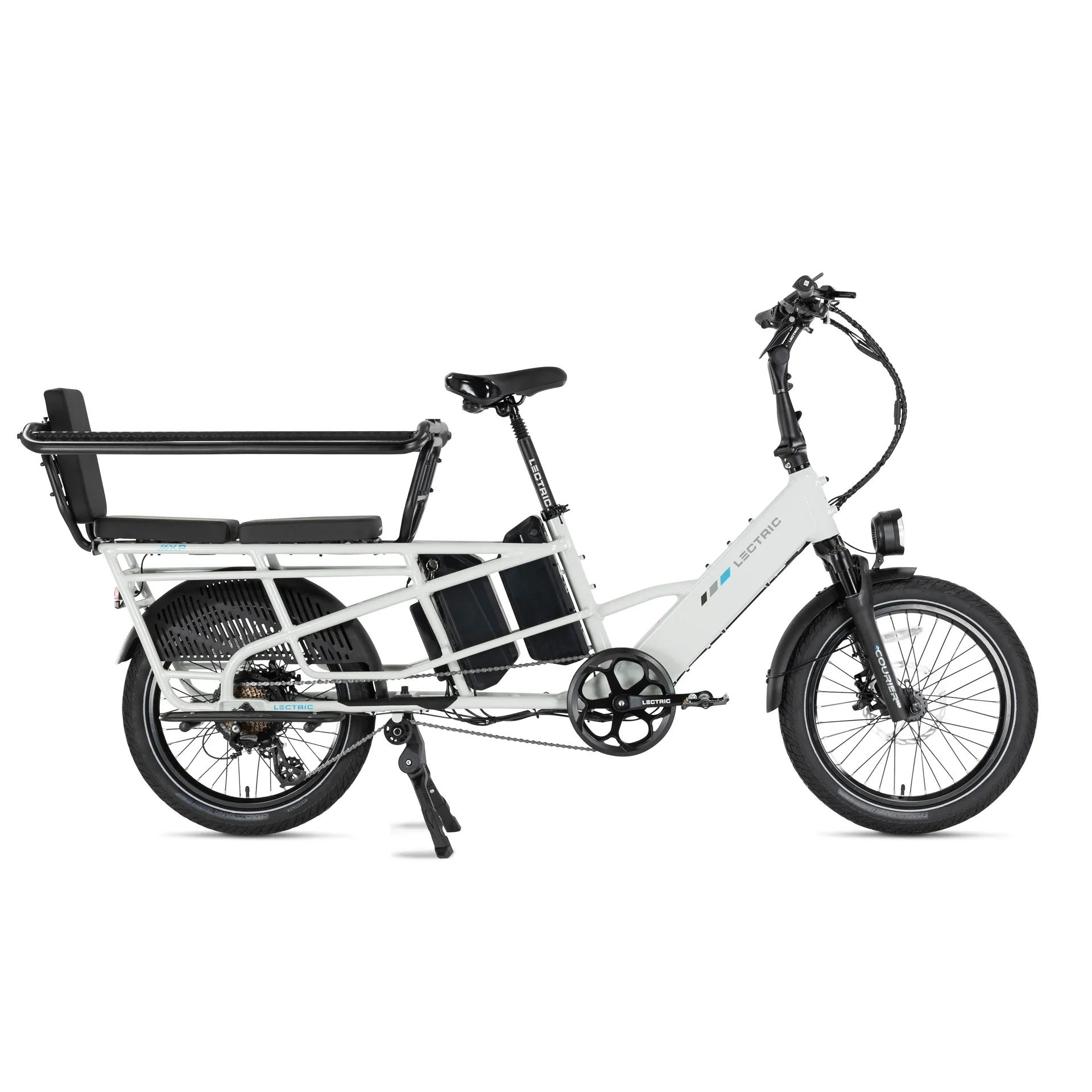
Throttle: Yes
Class: 1, 2, 3
Range: 60 miles (170 miles with long-range dual-battery)
Carrying Capacity: 450 lbs
Power Output: 1310 W
Bike Weight: 65 lbs (without batteries)
Pros: Excellent performance for price; list leader in range, power, and payload
Cons: Not the best handling, lacks premium feel
Best For: Budget-conscious, excellent range
One of our basic gear beliefs is that it’s not worth updating an already great product unless you can do something that meaningfully improves upon the previous design. Well, we absolutely loved the first Lectric XPedition, our favorite value cargo e-bike, but we have to say, the XPedition 2 truly is an improvement.
The Lectric XPedition 2.0 builds on a great platform, a true cargo e-bike born to haul heavy loads. The original option had two range options: a single battery, 75-mile range, or a dual-battery, 150-mile range. The newest version offers a third option: either get a 60-mile standard, 120-mile dual-battery, or 170 long-range dual-battery bike. That number may seem wrong, but it isn’t; it’s just astonishing from an e-bike. We’ve found that, even when heavily loaded, the latest XPedition 2 long-range dual-battery is a mileage beast, and we recommend going with that option if you can afford it initially (it is $2000, though). The peace of mind is worth it.
Other improvements to the new version include a bit slimmer tires paired with a front fork shock. The arrangement makes for a slightly more maneuverable ride, better for handling such a big e-bike. Plus, the fork shock absorbs bumps better than the old model’s fat tires. Finally, the new Orbiter (a wrap-around handle setup ideal for kids on the rear rack) has a more secure feeling, two bar system. Lectric keeps pushing the e-bike market forward, challenging what a brand can do while maintaining excellent value, and the latest XPedition 2.0 is another step in the right direction.
CHECK PRICE ON LECTRIC
The Lectric XPedition’s long tail has enough room for a basket and an adult passenger. Photo: Nathan Lemin//The Inertia
Runner-Up Best Cargo E-Bike
Aventon Abound SR Cargo E-Bike ($1,899)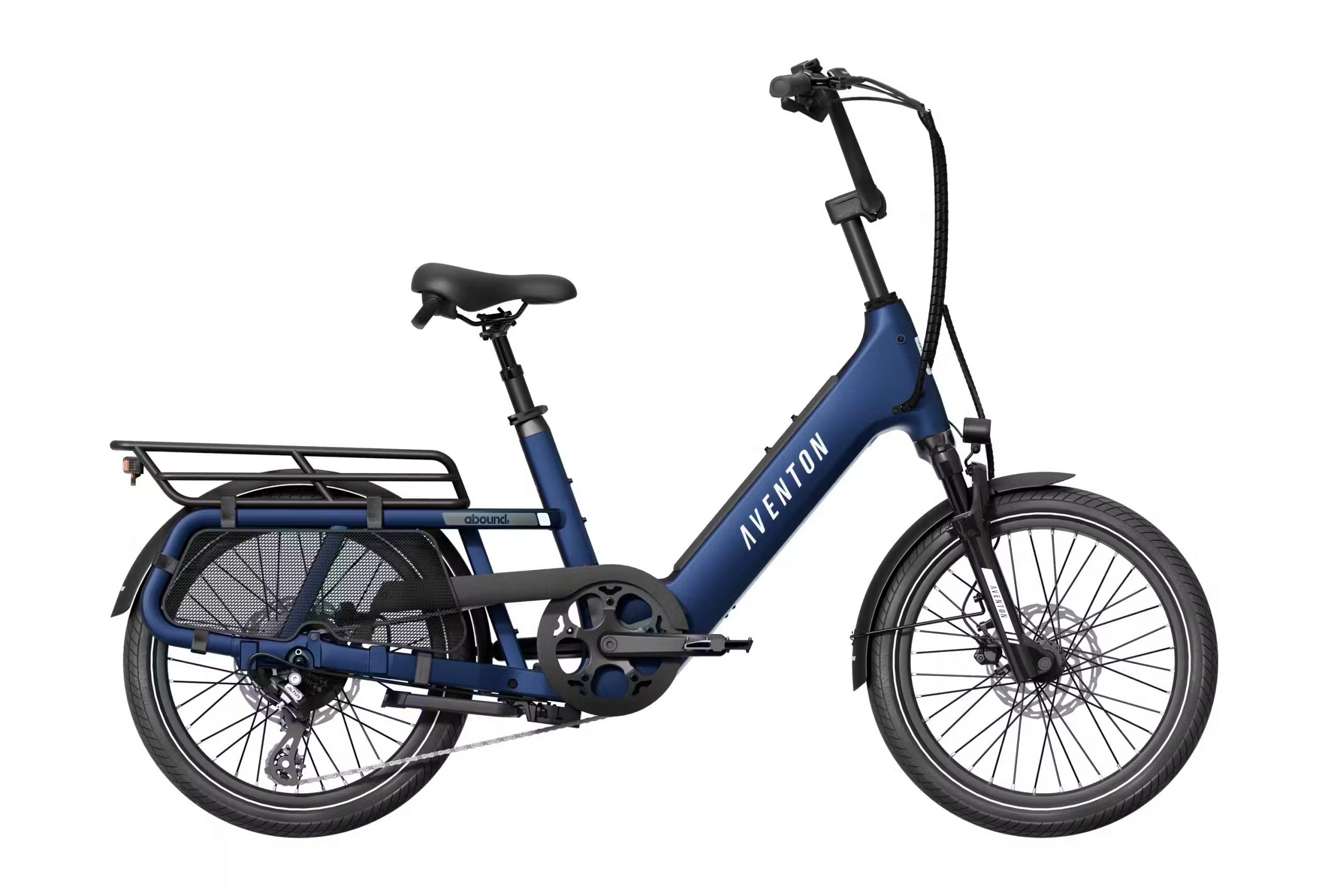
Throttle: Yes
Class: 2
Range: 60 miles
Carrying Capacity: 440lbs
Power Output: 750 W
Bike Weight: 88 lbs
Pros: Big payload, creative rack solutions, excellent price-to-feature ratio
Cons: Shorter cargo solutions may impede child seating
Best For: Most people—master of none, but great all-around
Aventon has been showing out with the latest iterations of already well-rated e-bikes. We recently started testing the new Aventon Abound SR (a short-tail version of one of our existing favorites, now the Abound LR). The Abound SR has blown us away with its value: You get top-of-the-line security features (remote location and controls, digital key, hub lock), a versatile and efficient class 2 setup, plenty of payload, all in a smaller, more maneuverable package than long-tail cargo e-bikes. One drawback to the security improvements is that it costs $20 per year (after a free first year) to connect the bike through 4G in order to use the security features; not a bad price, but one worth noting.
It’s hard to argue with Aventon’s popularity. Sure, there are cheaper e-bikes on the market. And of course, there are the super premium e-bikes that run well over $5,000. But we think the segment of the market that Aventon focuses on is right in line with what most people want and need. Excellent performance, easily accessible customer service, top-notch componentry, and genuinely good-looking e-bikes round out what we think is one of the best brands in the business.
The Abound SR is no exception, and it’s quickly become one of our favorites in the fleet due to its versatility. It’s not so large, heavy, and unruly to handle quick rides to the grocery store or around town. But it’s also plenty sturdy and spacious to carry even an adult passenger on the back. The updated security features offer a ton of peace of mind when locking it up around town, and the colorways are attention-grabbing. Long story short (tail, ha!), the Aventon Abound SR makes a perfect cargo e-bike for folks who don’t want a massive wheelbase bike parked in their garage or riding around town.
CHECK PRICE ON AVENTON
The Aventon Abound is feature-laden and quite affordable. Photo: Matt Medendorp//The Inertia
Best Compact Cargo E-Bike
Tern HSD S11 ($5,299)
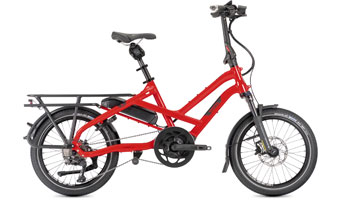
Throttle: No
Class: 3
Range: 32-76 miles
Carrying Capacity: 335 lbs
Power Output: 75 nm
Bike Weight: 62 lbs
Pros: More maneuverable than long tail, premium feeling bike (Bosch motor), stores vertically
Cons: Pricey, no throttle
Best For: Incredible features, stowing small
If you want a top-of-the-line hauler from one of our favorite e-bike brands, the new Tern HSD S11 can’t be beaten. Aside from the Specialized Haul LT, no other bike felt so nimble and natural to ride. The short-tail design of the HSD S11 can still haul an impressive 335 pounds, but it feels a lot easier to toss on your bike rack or fit in the garage.
Tern spares no expense when it comes to loading this bike with features. The Bosch Performance Line Sport motor is arguably the best of any cargo e-bike on the list, and certainly the most sought-after. That paired with the excellent Bosch Connect Module helps this bike stand out in the crowd. You can remotely lock out this bike, set an anti-theft alarm, and track it from your phone. That’s not all; while many bikes on this list have solid headlights and taillights, the Tern offers a low- and high-beam headlight!
All these added features, of course, come at a price, and aside from the Bunch Bike below, the Tern HSD S11 was the most expensive bike we tested. That, and the bike doesn’t feature any included accessories (or a throttle, but that’s not an issue for purists). The rear rack is one of our favorites, and you could dial this in on a budget with a little ingenuity. The HSD S11 also stores vertically, as in, you can lift it up and stand it on the rear rack in a surprisingly stable fashion. While at first, we thought this was gimmicky, it actually makes a huge difference when storing a bike inside a smaller space.
Of course, with anything you get what you pay for, and if you have it in the budget to pick up a Tern, we are confident you will not regret it, as this was a joy to ride.
CHECK PRICE ON REI
The compact size and lower weight of the Tern HSD S11 makes it easier to load up and take on a trip. Photo: Nathan Lemin//The Inertia
Best for Families
Rad RadWagon 5 ($2,399)
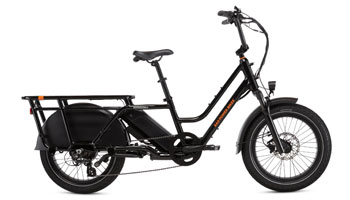
Throttle: Yes
Class: 2, 3
Range: 60 miles
Carrying Capacity: 375 lbs
Power Output: 750 W
Bike Weight: 86 lbs
Pros: Easy handling, Thule Mini Yepp bike seat capability (up to 2 at a time), best hill performance of the group, and fun color options
Cons: Battery fades quickly when using the throttle, heavier than others we tested
Best For: Tons of kid-friendly hauling options, solid build
Rad Power Bikes has quickly become one of the biggest names in the e-bike business. In our opinion, that’s great news. We love the new RadWagon 5. It’s solid, durable, and dependable. When our tester accidentally got stuck in a torrential summer monsoon, the Radwagon 5 had no problems firing back up and making it to the local bar for post-soccer-game refreshments.
The RadWagon is aided by the bike’s elongated frame and lower center of gravity. This translates to a more stable, reliable ride even if you’re fully loaded up to the bike’s 375-pound payload capacity. We also found the RadWagon was the most reliable hill performer, both on the pedal assist and throttle, and we felt we could race across risky intersections with ease. The Rad has a 750W motor, like others on this list, but it seems adept at getting more speed and performance out of it, which may account for how quickly it needs a recharge compared to its competitors.
Maybe most importantly for the parents in the crowd, the Radwagon was designed for hauling kids. Other bikes we tested, like our top choice, Specialized, have impressive kid configurations but need adapters to fit seats for little ones. Not Rad: the Thule Mini-Yepp seat integrates perfectly into the spacing of the back cargo rack. In fact, it can even handle two of them. The company also sells the seat on its site in a matching orange, proof that kid-centric design was baked in from the beginning. Other great points to note: the cargo bars have two options, an inner and an outer, that can both be run together or separately. The seat pads screw down instead of velcro, making them extra secure. The included saddle even has a handle on the back of it, making it easy to grab.
What kept this bike from the overall spot was the battery life. Don’t get us wrong, the battery will get you places. But the advertised 60-mile range is a little optimistic. Our tester found that more than any other bike on this list the Rad needed frequent charging. Not a huge deterrence, but definitely an annoyance.
Don’t miss our full review of the RadWagon 5.
CHECK PRICE ON RAD POWER BIKES
The Rad Wagon 5’s extensive accessory options make it ideally suited to hauling the kids. Photo: Matt Medendorp//The Inertia
Best Front Cargo E-Bike
Bunch Bikes Original 4+ ($6,499)
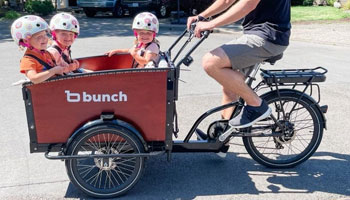 Throttle: Yes
Throttle: Yes
Class: 2
Range: 20-30 miles
Carrying Capacity: 350 lbs
Power Output: 48 nm
Bike Weight: 168 lbs
Pros: Huge cargo area, kids and pets love it
Cons: Bad handling, takes up a lot of space, lowest range in test, lower capacity than we’d like
Best For: Lots of kids or lots of pets, non-cyclists
While the Bunch Bikes Original 4+ was one of our least-favorite electric cargo bikes to ride, it was far and away the passenger favorite. Why? Its massive front cargo box and stable three-wheel design make it a lot easier for kids and dogs to grow accustomed to. This was also the favorite bike of non-cyclist testers, as the tricycle setup meant there was no need to take a foot off the pedals at stops or worry about tipping under load.
While the design of this bike is perfectly suited to folks with multiple children, multiple pets, or a large cargo loadout, it has some other nice features as well. We found kids and pups much prefer to be in front when riding—and indeed we do too—as it’s easier to see and communicate with them. We really liked the optional wheel lock, and the ability to customize the finely crafted cargo box with clever bench arrangements and seatbelts made this a fun bike to play around with. It’s pretty comfortable and straightforward to set up for novices.
Where the Bunch Bike fell short, however, was a direct result of its design. Riders of this bike found it very difficult to turn at speeds higher than a crawl, and when the cargo box is fully loaded, this handling unease is even more profound. And while you can dial in the seat and handlebars to an extent, we found this bike had one of the more unnatural-feeling cycling postures. The other elephant in the room: this bike! If you don’t have a huge garage or a dedicated space to park this 168-pound behemoth, steer clear. Finally, while many of the bikes on this list can be mailed through standard shipping or to a shop, the freight delivery required for the Bunch caused some headaches.
All that said, we think this is a perfect bike for certain buyers. Non-cyclists who want to replace the minivan with something more environmentally conscious will love the Bunch. Plus, they have a great program for adaptive bike needs. Of course, it is expensive, but if you’re planning on a true hauler for years to come, it’s a solid choice.
CHECK PRICE ON BUNCH BIKES
The Bunch Bike is the only one on this list to successfully haul three dogs! Photo: Nathan Lemin//The Inertia
Best of the Rest
Runner-Up Best Value Cargo E-Bike
Heybike Hauler ($1,499)
Throttle: Yes
Class: 3
Range: 55 miles (85 miles with dual battery)
Carrying Capacity: 440 lbs
Power Output: 750W (1400W peak)
Bike Weight: 88 lbs
Pros: Powerful motor, good payload capacity, best-in-class seat, solid price
Cons: Very heavy, smaller 20-inch tires less confidence-inspiring when handling and steering, lower quality componentry
Best For: Good payload and range performance at a competitive price
We had multiple testers get out on a Heybike Hauler, and while it performed competitively for the price, we felt that the Lectric XPedition featured better performance for the price. That said, the Hauler is an excellent entry-level bike, with a more compact frame size and some useful cargo racks included. Plus, the high peak output on this motor made for one of the fastest accelerating cargo e-bikes we’ve tested.
Both testers experienced some difficulty getting the handlebars, stem, and front fork assembled properly; after some troubleshooting and adjusting, we were able to figure it out. We wanted to make note of this because, as pretty experienced cyclists, we felt that this bike may be difficult to set up for a novice.
On the flip side, this was one of the more fun bikes to ride: Acceleration and overall performance were punchy and exciting. That pep led to a bit of uncertainty when handling, and the smaller wheels don’t inspire a ton of confidence when zipping around town (the heavy overall weight is also likely to blame). There are a lot of cargo accessories available for the Hauler, but we felt like the range leans a bit more cargo-relevant than passenger-friendly (though we did like the flip-up footrests).
Overall, if you’re looking for a great bike for around $1,500, we found the Heybike Hauler to be a solid value. While it didn’t beat out the Lectric XPedition for pure value, it does offer plenty at the price, and we found the Heybike team to be responsive to questions.
Check Price on Heybike
The Heybike Hauler is a great size—a bit more compact than long-tail cargo e-bikes. Photo: Tucker Adams//The Inertia
Ride1UP Vorsa ($1,695)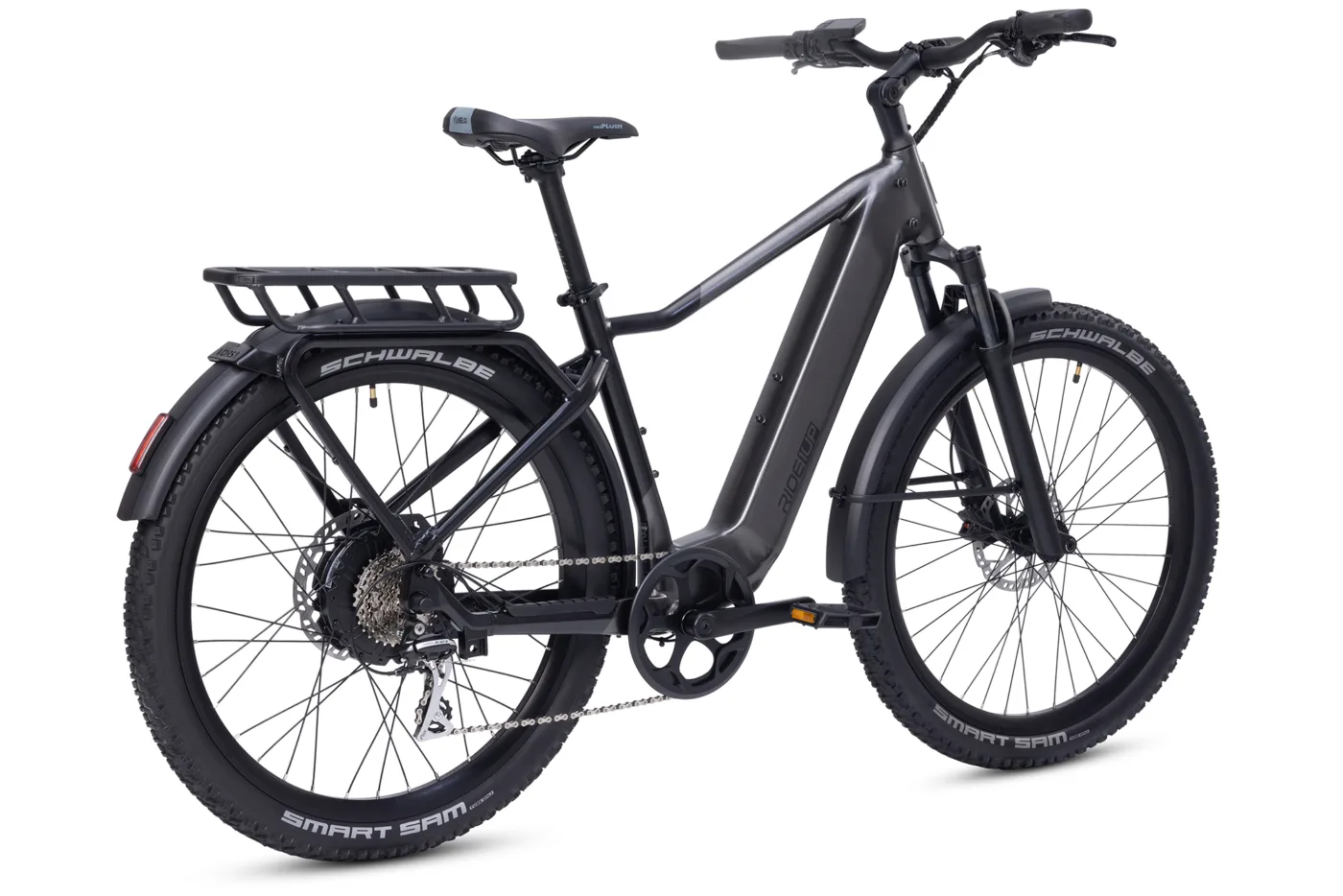
Throttle: Yes
Class: 3
Range: 30-60 miles
Carrying Capacity: 440 lbs
Power Output: 750W (95 nm)
Bike Weight: 70 lbs
Pros: More versatile than true cargo e-bike, great value
Cons: Less stable than true cargo e-bike, rear rack only supports 150 pounds
Best For: Perfect for someone who wants standard e-bike with cargo capability
Cargo e-bikes tend to all look the same: Lower to the ground, with a step-through frame for easy loading, and a longer tail for hauling passengers/cargo. They’re the minivans of electric bikes. New this spring, Ride1UP released the Vorsa, which they are calling an “SUV-inspired e-bike.” With rugged full-frame looks, tons of modularity, smart features, and a whopping 440 lb payload capacity, this is no compact crossover SUV, but an Escalade among e-bikes, to keep the metaphor going.
Versatility is the name of the game with the Vorsa. The modular rear rack lets you carry both a full-sized adult passenger and cargo at the same time, while numerous mounting points across the frame. The bike also comes equipped with the latest e-bike features to hit the market recently, namely FindMy tracking, and rider-selectable torque/cadence modes for different ride-feels. The bike has tons of power (750-Watt/95 Nm motor), solid battery life, and settings for Class 1-3 riding, as well as an off-road mode which can be activated for use on private land.
In comparison to a true cargo e-bike, like the Lectric XPedition 2, however, the Vorsa does come up short in a couple of respects. Being a full-frame e-bike, the taller frame is not as conducive to easy on/off as the shorter frames of cargo e-bikes, and the load is higher off the ground as well. A step-through version of the bike is available, but it is still only recommended for riders 5’1” tall at the shortest. And while the long-tail extension lets you carry a passenger and cargo, it does not allow for the sort of two-kid-hauling capacity of a long-tail cargo e-bike. Finally, a side, rather than a center-mounted kickstand, is not as useful for stable loading of cargo. However, if versatility and stylish full-frame looks are what you’re after in an e-bike, as well as a high level of customization, gear or passenger-hauling capabilities, and high-tech features like dual sensors and FindMy tracking, the Vorsa delivers in spades.
Check Price on Ride1UpBest Electric Cargo Bikes Comparison Table
| Cargo E-Bike | Price | Class | Claimed Range | Power | Weight | Top Speed | Payload |
| Specialized Haul LT | $3,500 | 2, 3 | 60 miles | 750 W | 88 lbs | 28mph | 441 lbs |
| Lectric XPedition 2.0 | $1,399 | 2, 3 | 75 miles | 1310 W | 68 lbs | 28 mph | 450 lbs |
| Aventon Abound SR | $1,899 | 2 | 50 miles | 750 W | 82 lbs | 25 mph | 440 lbs |
| Tern HSD S11 | $5,299 | 3 | 32-76 miles | 75 nm | 62 lbs | 28 mph | 335 lbs |
| RadWagon 5 | $2,399 | 2, 3 | 60 miles | 750 W | 86 lbs | 28 mph | 375 lbs |
| Bunch Bike 4+ | $6,499 | 2 | 20-30 miles | 48 nm | 168 lbs | 20 mph | 350 lbs |
| Heybike Hauler | $1,499 | 2, 3 | 55 miles | 750 W (1400 W peak) | 88 lbs | 28 mph | 440 lbs |
| Ride1Up Vorsa | $1,695 | 1-3 | 30-60 miles | 750 W (95 nm) | 70 lbs | 28 mph | 440 lbs |

Cargo e-bikes make commuting, joy rides, and grocery trips a little easier. Photo: Tucker Adams//The Inertia
How We Tested Electric Cargo Bikes
Over the past three years, we have kept a close watch on the rapidly expanding e-bike demand, getting our hands on the latest and greatest cargo e-bikes too. Not everything we tested made the final cut and the ones that did were personally tested by our team.
Our testers covered different geographic regions and scenarios to put these bikes through their paces. Matt Medendorp used cargo e-bikes to haul two kids around through a series of errands, preschool drop-offs, and soccer games in a busy Midwestern city. Nathan Lemin tested cargo e-bikes to haul dogs, groceries, and gear around Arizona. Most of the bikes on this list we assembled ourselves, with the rare help of local bike shops (like with the Specialized Haul LT).
We also tested various configurations and scenarios — how the bikes rode with cargo racks and without cargo racks, loaded with passengers and solo. We tested charging anomalies by removing the batteries and charging them separately and by charging the batteries on the bike. Our testers also tried each bike until it was completely out of battery and pedaled it without any electric assist to see how easy it would be to handle sans electric assist. We also weather-tested the bikes on wet pavement and in rainstorms and tried them on a variety of road conditions from dirt to gravel to paved.
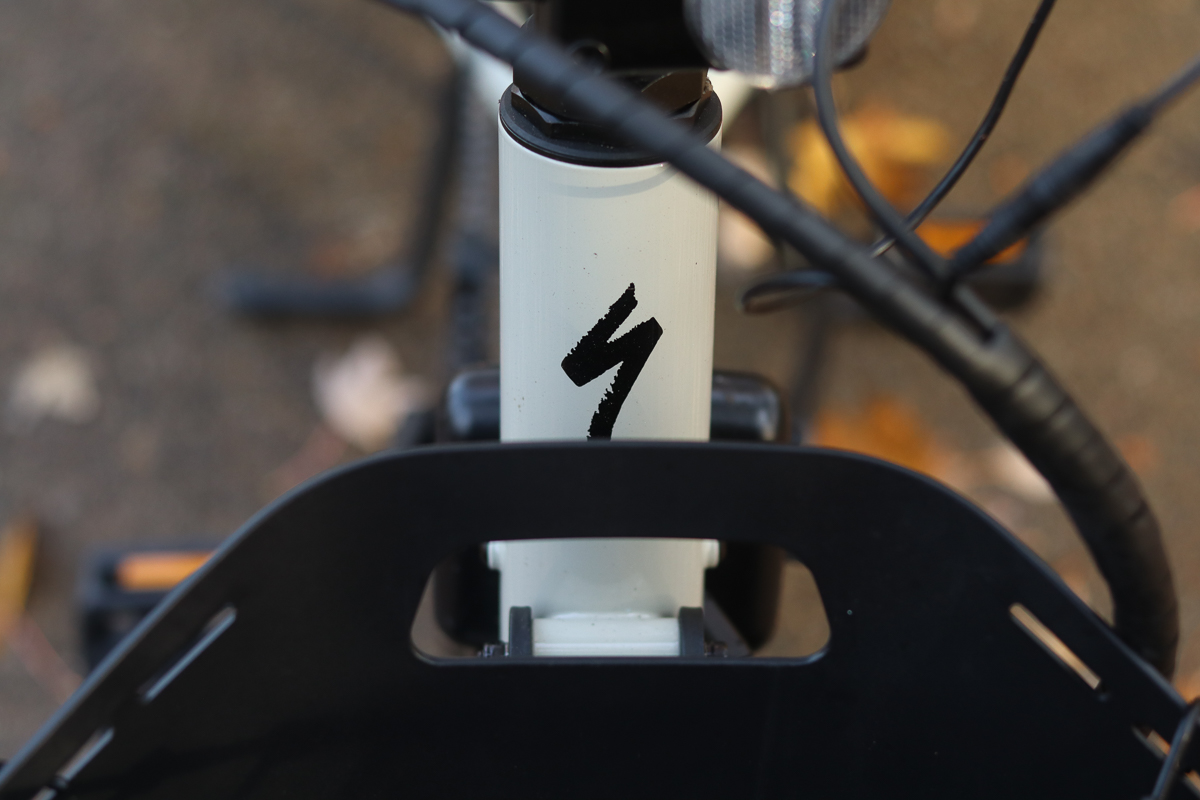
In all of this, we evaluated the following factors to make our final selections on this list:
Speed
We considered not only top speed but acceleration, especially up a hill, to be important here. E-bikes that ranked well could achieve speed and maintain it through various ups and downs.
Capacity
In a cargo e-bike guide, each option’s ability to haul cargo was analyzed. While every bike on the list boasted at least 300 pounds of payload capacity, some were able to carry well over 400 pounds.
Components
We’re talking shifters, brakes, drivetrain, etc. If these aren’t held to a standard of high quality, the bike won’t work properly in the long term. Especially because electric cargo bikes are much heavier than a standard pedal bike, having good components to withstand the extra wear and tear is important.
Battery
Does the battery hold a charge for long enough to be useful? Does it charge in a reasonable amount of time? These are important questions when thinking of the regular, everyday use of a cargo e-bike. With a cargo bike, the range often changes based on how much gear is loaded on, so we tested the bikes both fully loaded and completely empty.
Style
Sure, this is far from objective, but it’s something we considered. Each of these bikes costs over $1,000, and for that amount of money you’d like to get something enjoyable to ride and nice to look at. An e-bike’s appearance didn’t factor into any of the reviews of the bike’s performance factors, but we took it into account while ranking and selecting bikes.

Racks, seats, pannier bags: Accessories and add-ons are an important consideration for cargo e-bikes. Photo: Matt Medendorp//The Inertia
Electric Cargo Bikes Buyer’s Guide
With so many options to choose from, finding the best cargo electric bike for your needs may seem daunting. Fear not, as we have distilled the most important factors to consider when buying the ideal e-bike for your needs.
Battery Life and Quality
This is the heart and soul of your electric bike. A quality battery not only assures longevity but also reliable power when you need it. Check the battery’s voltage and amp-hour – higher values will give you more power and range.

While a sophisticated computer system is nice, as long as the essentials are displayed we’re happy. Photo: Tucker Adams//The Inertia
Motor Placement
Motor placement affects the bike’s balance and ride feel. Hub motors are common and provide good power, but mid-drive motors offer better balance and efficiency, especially in hilly terrain.
Torque Sensor vs Cadence Sensor
Not always discussed in the e-bike world, deciding on a torque sensor or a cadence sensor makes a huge difference in how your cargo e-bike will ride. Essentially, cadence sensors lend electric assist based on how fast you are pedaling, regardless of how hard you are pedaling. If that sounds confusing, think of it this way: When you’re pedaling in an easy gear, you aren’t pedaling hard, but you are likely pedaling fast. Cadence sensors will give you the same amount of assistance with that easier, faster pedaling.
Torque sensors, on the other hand, are a bit more sophisticated and give you electric assistance based on how hard you are pedaling. Say you’re really giving it to get up a hill: The torque sensor will give you a big boost even if you’re pedaling slowly, and even out when you get on easier, more level ground. Higher-end bikes like the Specialized Haul LT and Tern HSD S11 feature torque sensors.
So what’s better? It’s all preference: One of our testers prefers cadence sensors for the snappy acceleration and loads of help, but riders coming from the cycling world tend to prefer the more natural response of a torque sensor.
Racks and Add-Ons
To be a proper gear hauler, you need to be able to bring an extra kit along for the ride. Beyond racks, some companies offer additional features that you can add to the kit like integrated lights, passenger seats, baskets, and more, making it much more than just a bike to get from point A to point B. We tested each bike in a variety of configurations – loaded with kids and loaded with groceries.
Terrain
Even though these aren’t as burly as fat tire electric bikes, chances are you’ll want to take it off the pavement. So we took into account how well the electric bikes actually perform when the asphalt turns to gravel, dirt, or sand. If your main goal is to have a bike that will deal with sand, you’ll want to choose the fattest tires possible and a strong motor, like the Radwagon 4 which handles more like a moped than a bike (in a good way).

From pavement to gravel, we tested these cargo e-bikes in realistic riding scenarios. Photo: Tucker Adams//The Inertia
Cargo E-bike Range
Consider how far you plan to travel on a single charge. Cargo e-bike ranges can vary greatly, so choose a bike that exceeds your typical ride distance, keeping in mind that factors like terrain, rider weight, and cargo load impact the actual range. The Lectric XPedition was the star as far as range—even fully loaded with two adult riders, we did a full-day 50-mile ride and still had about half of our battery capacity left.
That said, in general, we noticed our batteries drained quickly when fully loaded with gear and/or passengers. Weather—both cold and hot—can affect your battery and therefore your range, too.
Ease of Setup and Use
Ensure the bike’s controls are user-friendly, and it’s easy to monitor battery life, switch power modes, and manage other functionalities. This is where the budget bikes and the higher-end bikes are differentiated. We found the Heybike Hauler to be pretty difficult to set up.
Bike Weight
Cargo electric bikes are the heaviest of the e-bike weight class. Make sure you can handle the weight. We wouldn’t recommend carrying any of these upstairs or storing them in elevated places. Surprisingly, despite its large frame, the Lectric XPedition was on the light end of the weight spectrum.
Riding Comfort
When first riding the e-bike, check the comfort level. Pay attention to the posture, adjustability, seat, handlebar height, and the overall riding experience. Front forks can help alleviate road bumps, though we found with these heavy, larger tire cargo e-bikes, that bumps and pavement cracks were usually pretty smooth.
Warranty and Support
A solid warranty and accessible customer support signify the manufacturer’s confidence in their e-bike and their commitment to your satisfaction. Companies like Specialized shine in the customer-support department, and are indeed a plus when choosing a bike like the Haul LT.

A well-situated rack and comfortable seats for the kiddos were top-of-mind when testing. Photo: Matt Medendorp//The Inertia
Cargo Accessories
Don’t overlook the availability and compatibility of accessories like fenders, racks, and lights, which add functionality and safety to your rides. Cargo bikes often come with seats for passengers and kid-safe adaptations, but you’ll want to check to see. Some also come with turn signals. E-bikes like Bunch Bike 4+ and RadWagon 5 go all-in on passenger accessories and therefore were favorites of the little ones.
Style
Do you want to hide the fact that you’re riding an electric bike or shout it from the rooftops? Some traditional-styled electric bikes like the Specialized Haul LT hardly look like an electric bike at all, until you start gliding uphill that is. Some of the other cargo bikes look decidedly eclectic (and a little European) in their geometry. They’re a bit goofy, like the Aventon Abound’s very upright handlebars, but the goofiness is part of their charm.
Throttle or Pedal Assist (or Both)
Some electric bikes come with a throttle, some are pedal assist only. Pedal assist is great for those looking to go longer distances as it uses far less electric power and for those looking for more of a traditional bike experience. Throttle capabilities are super fun and great for those who would have gone with a Vespa over an electric bike if it weren’t for the special license required to drive motor scooters here in the States.

We loved a front basket for tossing gear, especially when the rear cargo space is carrying passengers. Photo: Matt Medendorp//The Inertia
Cargo E-Bike Classification
There are three classifications for electric bikes. As with any fun new invention, regulation varies state by state, so be sure to check local laws to make sure your electric bike is compliant where you live.
Class 1 electric bikes go up to 20 mph on pedal assist only, meaning they don’t have a throttle and can be taken anywhere you can ride a regular, non-electric bicycle.
Class 2 e-bikes also top out at 20 mph but with a throttle. You can take a Class 2 electric bike almost anywhere you can take a Class 1, but they are often restricted from single-track mountain bike trails due to the damage the instant torque of a throttle can produce.
Class 3 e-bikes can be a bit confusing, but they can achieve a top speed of 28 mph with pedal assist. Usually, class 3 bikes are also class 2 bikes, meaning you can throttle up to 20 mph, and pedal beyond that up to 28 mph. Class 3 e-bikes are typically allowed on roads and are often restricted from bike trails and multi-use pathways.
Note: Some electric bikes can be unlocked to reach speeds even higher than 28 mph, often accessed by a specific mode on the bike, which is only supposed to be used on private land.

Keeping the moving parts well-maintained on a cargo e-bike is critical for longevity. Photo: Tucker Adams//The Inertia
Caring For Your Electric Cargo Bike
For most of us, shelling out hard-earned money for an electric bike isn’t taken lightly. So the best way to ensure that the purchase is a smart one is to make sure you’re taking care of your investment. Nothing is too difficult but there are a few pointers we’d like to share to help ensure your electric bike has a long and healthy life, and that your relationship to your bike is one of mutual respect.
Storage
Treat your electric bike to a safe haven away from the elements, ideally indoors or under a protective cover. This will keep it snug and protected from rain, snow, and harsh sunlight, preserving its good looks and performance. That said, we did test each of these bikes in the rain and other inclement weather and they held up well, but that’s not a strategy for long-term maintenance.
Battery Care
Ensure your battery leads a long and happy life by charging it regularly and avoiding extreme temperatures. Remember to unplug it once it’s fully charged and store it separately if you won’t be using your electric bike for an extended period.

Ensure your wiring harnesses are securely connected to avoid dust and moisture from entering. Photo: Matt Medendorp//The Inertia
Computer and Wiring
We also recommend keeping an eye on your wiring and cargo e-bike computer. Some units with folding handlebars are prone to wiring disconnects, so if lights, computers, or throttles aren’t working, it’s probably a safe bet that a wire came unplugged. This is usually an easy fix, and we like to check that our e-bike wiring harnesses are hooked up properly every few rides to keep dust and moisture out of connections.
Keep it Clean
Give your electric bike a gentle wipe down with a soft cloth, removing dirt and grime without scratching its surface. Pay special attention to the electrical components, keeping them clean and dry for optimal functionality.
Chain TLC
Show your electric bike’s chain some love by lubricating it regularly and ensuring it’s properly tensioned. This will keep it running smoothly and prevent any unexpected hiccups during your ride.
Brake Check
Since electric bikes usually weigh significantly more than standard bikes, their brakes have to work much harder to stop quickly. As such, they tend to wear out faster. Make sure your brakes are always in tip-top shape, adjusting them as needed and replacing worn pads or cables. This way, you can trust your e-bike to stop on a dime when things get hectic out there.

Giving the cargo e-bike a rinse every once and a while is key—just make sure you’re not damaging the battery or wires. Photo: Tucker Adams//The Inertia
Tires
Keep your tires inflated to the recommended pressure and check them for wear and tear. This will not only provide you with a smoother ride but also reduce the risk of punctures or other issues that could leave you stranded.
Regular Checkups
Just like any dependable sidekick, your electric bike deserves regular check-ins. Perform routine inspections and maintenance to keep it running at its best, addressing any issues before they become major problems.
Return To: Top Picks | Comparison Table
Editor’s Note: For more top e-bike picks, check out our guides to the Best Fat Tire E-Bikes and the Best Folding E-Bikes. For more gear reviews and features on The Inertia, click here.



